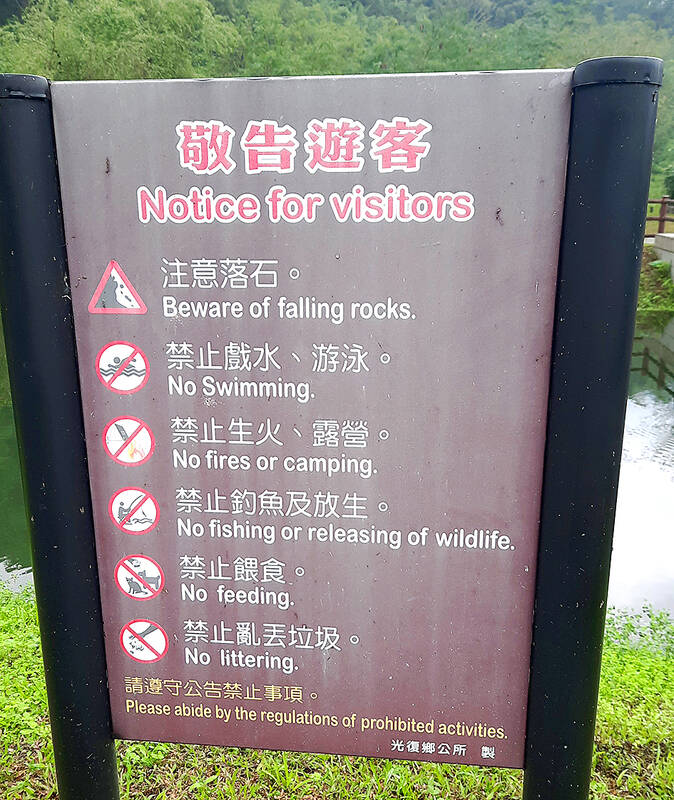At scenic spots throughout Taiwan, it isn’t unusual to find notices that prohibit camping and barbecuing. In several places, these warning signs also remind visitors not to engage in an ancient practice that Mandarin-speakers call fangsheng (放生).
On its Web site, SPCA HK, an animal welfare group in Hong Kong, describes fangsheng as “a religious act; many Buddhists and Taoists believe that releasing captured animals creates good karma, bringing good fortune.”
Fangsheng practitioners release birds, reptiles or fish to earn merit. In the distant past, animals destined for slaughter were purchased and freed. But the practice has created an industry. In several Asian countries, massive numbers of creatures are bred or captured specifically for such rituals.

Photo: Tsai Wen-ru, Taipei Times
‘NOT KIND’
English-language sources often translate fangsheng as “mercy release,” but SPCA HK places additional quotation marks around the first word, because the practice often results in the death of the creatures that are released. If the animals do survive, their introduction may wreak ecological havoc. SPCA HK says it is “campaigning hard to stop so-called ‘mercy’ releases. It is not kind and is not part of a coherent conservation process.”
As might be expected in a country where traditional religious beliefs still influence a large part of the population, mercy release has had a noticeable impact on Taiwan’s ecosystems.

Photo: Tsai Wen-ru, Taipei Times
Bill Murphy, an American who spends much of his free time herping in the hills of northern Taiwan and co-creator of the www.snakesoftaiwan.com Web site, says that from time to time he finds snakes that “shouldn’t be there at all in the first place. Twenty years ago, for example, it was rare to find cobras or king ratsnakes at such high elevations. But in recent years, certain religious groups have ‘rescued’ large numbers of these snakes and dumped them up there.”
“No doubt they meant well, and thought they were releasing them into a beautiful habitat where they’d thrive, but these animals have a profound impact on the other species up there,” says Murphy.
Both cobras and king ratsnakes are prolific snake-eaters, he says. “A number of other snake species have disappeared almost entirely up there due to the predation of these invasive species. They should be collected and removed, or euthanized,” he says.

Photo: Liu Pin-chuan, Taipei Times
Murphy is sure that the cobras and king ratsnakes he encounters were released by humans, “because their snouts are clearly wounded from being caged and trying to get out. Also, they’re unusually docile in many cases, as if they’ve been handled a lot.”
According to Liu Chi-chang (劉奇璋), an associate professor at National Taiwan University’s School of Forestry and Resource Conservation, mercy releases of fish also cause problems.
The tiger groupers and the Epinephelus fuscoguttatus-Epinephelus lanceolatus hybrids that were released into the seawater at Keelung’s Chaoyang Park (潮境公園) have been preying on native marine creatures, he says.

Photo: Steven Crook
“People usually release non-indigenous species, because of their availability and price, and the result is biological invasion,” Liu says.
NEW RULES
The government recently tightened the regulations which govern the release of aquatic animals into the sea, prohibiting the use of species that are exotic, hybrid, genetically modified or which “do not conform to the principles of ecological conservation.” Under the new rules, from Jan. 1 next year, all sea releases must be carried out by individuals who have received six or more hours of education and training on sea-creature release operations.
The regulations are designed to ensure that only releases approved by the authorities go ahead, yet some groups still conduct mercy-release rites without first obtaining permission, Liu says.
An initiative by the Taiwan Ocean Conservation and Fisheries Sustainability Foundation (臺灣海洋保育與漁業永續基金會) offers a way forward. The foundation, which has received funding from the Council of Agriculture’s Fisheries Agency, has begun working with religious groups to combine approved releases of fish seedlings with mercy-release rites. Liu describes this as “a win-win situation that not only satisfies religious demands, but also increases marine fisheries resources.”
CAMPAIGN
Because fangsheng had been a feature of the local religious landscape for so long, few Taiwanese considered that mercy release might be “a bad thing done by well-intentioned people” before the Environment and Animal Society of Taiwan (EAST) began investigating and campaigning against it two decades ago, says EAST Director Lin Dai-ching (林岱瑾).
The NGO surveyed religious institutions, then published a report in 2004 that caught the eye of government officials. Soon after, the Ministry of the Interior formally urged the religious organizations it supervises not to engage in mercy-release activities.
In 2007, the Nantou County Government became the first local authority in Taiwan — and possibly the first in the world — to issue rules regulating animal releases. Nantou’s ordinance requires the county government to announce which species cannot be released into the wild and the locations where all releases are prohibited. It also requires groups organizing fangsheng events to obtain official approval in advance, and allows the county government to fine those who violate the rules up to NT$100,000.
According to Lin, these proclamations had a real impact. Religious groups and temples don’t want to break the law, so “some have turned from releasing animals to assisting students, promoting vegetarianism, donating money for more nutritious school lunches or donating to social welfare and stray-dog groups,” says Lin.
Scholars were commissioned to study the ecological impact of released species. In 2007, Academia Sinica hosted a two-day international symposium on religion, animals and the environment.
“Additional scientific evidence helped convince the public that mercy release is very often harmful to natural ecosystems,” Lin says.
Lin believes that mercy release is less common than it was, but she stresses that there hasn’t been a recent nationwide survey of the practice. A 2004 survey found that 483 temples and groups in Taiwan engaged in mercy release, spending upward of NT$200 million on such activities each year, setting free more than 200 million creatures, many of them being fry (very young fish). A 2009 followup survey reached 388 of those institutions: Some 256 said they were still releasing animals, while 98 said they were not. Another 34 reported not having conducted any recent releases, and being uncertain if they would do any in the future.
EFFECTIVE ALTERNATIVE
The EAST director praises the work of Lin Kuo-chang (林國彰), a section chief in the Forestry Bureau, who worked with EAST to communicate with religious groups, eventually arranging for them to make donations to wildlife conservation NGOs and the government-run Endemic Species Research Institute.
One of the institute’s roles is the rescue and rehabilitation of wild animals. Now, when the time comes to return an animal to the wild, religious groups are invited to participate.
“This is turning the old mercy-release rite into a life-protection ceremony, and this collaboration continues to this day,” Lin Dai-ching says.
Asked how Taiwan has been able to reduce the incidence of mercy release in a relatively short time, when it often takes many years to slightly move the needle on other environmental issues, Lin says that a lot depends on whether proposed reforms are likely to upset economic interests.
“Based on my observations and experiences when working on issues, if there’s success or change in a relatively short period of time, it’s probably because only a small number of people engage in this behavior, and the economic impact is relatively minor,” she says. “In those cases, the government doesn’t have to worry about protests, and elected representatives probably follow the same logic,” she says.
Lin gives as examples the passing of laws that prohibit the import of seal products and ban the killing and eating of dogs and cats.
By contrast, she points out, the authorities have signaled their disapproval of the Hakka practice of force-feeding “divine pigs” for religious sacrifice, but “they dare not categorically prohibit it.”
Steven Crook, the author or co-author of four books about Taiwan, has been following environmental issues since he arrived in the country in 1991. He drives a hybrid and carries his own chopsticks. The views expressed here are his own.

This month the government ordered a one-year block of Xiaohongshu (小紅書) or Rednote, a Chinese social media platform with more than 3 million users in Taiwan. The government pointed to widespread fraud activity on the platform, along with cybersecurity failures. Officials said that they had reached out to the company and asked it to change. However, they received no response. The pro-China parties, the Chinese Nationalist Party (KMT) and Taiwan People’s Party (TPP), immediately swung into action, denouncing the ban as an attack on free speech. This “free speech” claim was then echoed by the People’s Republic of China (PRC),

Exceptions to the rule are sometimes revealing. For a brief few years, there was an emerging ideological split between the Democratic Progressive Party (DPP) and Chinese Nationalist Party (KMT) that appeared to be pushing the DPP in a direction that would be considered more liberal, and the KMT more conservative. In the previous column, “The KMT-DPP’s bureaucrat-led developmental state” (Dec. 11, page 12), we examined how Taiwan’s democratic system developed, and how both the two main parties largely accepted a similar consensus on how Taiwan should be run domestically and did not split along the left-right lines more familiar in

Specialty sandwiches loaded with the contents of an entire charcuterie board, overflowing with sauces, creams and all manner of creative add-ons, is perhaps one of the biggest global food trends of this year. From London to New York, lines form down the block for mortadella, burrata, pistachio and more stuffed between slices of fresh sourdough, rye or focaccia. To try the trend in Taipei, Munchies Mafia is for sure the spot — could this be the best sandwich in town? Carlos from Spain and Sergio from Mexico opened this spot just seven months ago. The two met working in the

Many people in Taiwan first learned about universal basic income (UBI) — the idea that the government should provide regular, no-strings-attached payments to each citizen — in 2019. While seeking the Democratic nomination for the 2020 US presidential election, Andrew Yang, a politician of Taiwanese descent, said that, if elected, he’d institute a UBI of US$1,000 per month to “get the economic boot off of people’s throats, allowing them to lift their heads up, breathe, and get excited for the future.” His campaign petered out, but the concept of UBI hasn’t gone away. Throughout the industrialized world, there are fears that